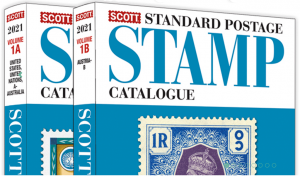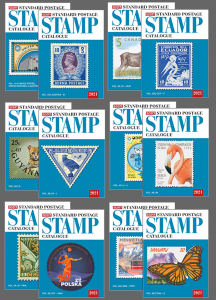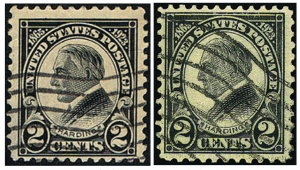The Hardest Part of Collecting is Beginning, Part 3 — Catalogues
By John M. Hotchner
An essential tool as you add to your collection is a stamp catalog. In the United States, that means having, or having access to the Scott Standard Postage Stamp Catalogues.
Scott covers the world in what used to be six ungainly volumes that took up 14+ inches of shelf space. Effective with the 2018 Catalogues, each was divided into two thinner (about one inch) volumes as follows:
- Vol. 1A: United States and A countries through Australia./ Vol. 1B: Austria through B countries
 Vol. 2A: C through Cur countries
Vol. 2A: C through Cur countries- Vol. 2B: Cyp through F countries
- Vol. 3A: G countries
- Vol. 3B: H through I countries
- Vol. 4A: J through L countries
- Vol. 4B: M countries
- Vol. 5A: N through Phil countries
- Vol. 5B: Pit through Sam countries
- Vol. 6A: San through Tete countries
- Vol. 6B: Thai through Z countries
Where to get Scott Catalogues? They are published by Amos Press, and available on the Amos Advantage website. They are sold as complete volumes (1, 2, 3, 4, 5, and 6) for about $105 each. While this is a steep investment in your collection — especially for someone getting started — catalogues are a gold-mine of information and an essential reference for every collector.
Why? First, they tell you what stamps each country has issued since they began issuing stamps, and a vast number of them are pictured to facilitate your finding the ones you have in your collection. Each stamp listed is valued in both Mint and Used condition. And  each stamp is assigned a number that becomes its universally understood reference point for all collectors and dealers. The latter is important when you look at printed price lists, offerings on Internet sites, or in auction catalogues.
each stamp is assigned a number that becomes its universally understood reference point for all collectors and dealers. The latter is important when you look at printed price lists, offerings on Internet sites, or in auction catalogues.
As a beginner, you may want the current year’s catalogue(s) that include the countries you collect; and that may be important if you are going to buy high-priced stamps. Each year the values shown for each stamp are reviewed in light of actual prices being paid and adjusted up or down.
But for most of us, steeply discounted older catalogues from one or two years earlier are adequate as references. You may even be able to find Scott Catalogues in the reference section of your local library. But that means you can’t check them out of the library. If you want one that you can use at home, stamp clubs often have a set of current or at least recent catalogues that members can borrow.
If you want one or more volumes of your own, you can often find prior years’ volumes available on Internet sales sites, in club auctions, advertised by dealers, or available on  their tables at stamp shows. You can also get together with another collector to buy catalogues that you can share.
their tables at stamp shows. You can also get together with another collector to buy catalogues that you can share.
How to use the catalogue? Each of the 12 catalogues has a section at the front that tells you how to use the catalogue: how to understand the listings, definitions for the terms used, how the values shown are arrived at, and much more. I won’t repeat all of that here. But what is most important for the stamp buyer is to understand how the values shown in the catalogue translate to selling prices that you are asked to pay when you buy.
As noted earlier the Scott editors arrive at prices based on actual prices being paid in the marketplace for stamps in the grade of Very Fine. On the low end, Scott prices every used stamp at a minimum of 25¢ and every mint stamp at a minimum of approximately twice face value. This recognizes that the cost of any given stamp has to include a dealer’s overhead (equipment, space, staff, and time) needed to set up as a dealer. It does not mean you have to pay that price.
In fact, dealers (and collectors who sell their duplicates) often discount from the Scott prices based on the desirability of the stamp. That is defined as a combination of the popularity of the collecting area, the level of rarity of the stamp, its condition, and if used, the intensity of a cancellation. It is unusual that actual price will equal or exceed the Scott Catalogue value. Usually that happens when dealing with a popular collecting area and the condition of a scarce stamp is at the high end of the condition continuum.
The catalogue number identification of a stamp being offered cannot always be taken as gospel; especially when the stamp being offered is an older, expensive one. The catalogue is accurate, but the identification of the stamp may not be. Such complicating factors as watermarks, perforation sizes, paper types, design types, precise color identification, and, on modern stamps, the presence and type of tagging can affect proper identification. It is also possible to “make” a more valuable stamp from a less valuable one; say a coil pair from an imperf pair. One version of a given stamp may be 25¢, while another stamp that on first glance looks just like it, may have a catalogue value of tens of thousands of dollars.
 Take a look at the picture on the right, in which are copies of Scott #610 and #613. The former, a perf 11×11, flat plate-printed black stamp, is catalogued 25¢ used. The latter, a perf 11×11 rotary press printing in black, catalogues $37,500. The difference is a quarter millimeter in the height of the stamp design!
Take a look at the picture on the right, in which are copies of Scott #610 and #613. The former, a perf 11×11, flat plate-printed black stamp, is catalogued 25¢ used. The latter, a perf 11×11 rotary press printing in black, catalogues $37,500. The difference is a quarter millimeter in the height of the stamp design!
For this reason, and because the art and science of repairing damaged stamps has reached a high level in the modern era, a certificate of authenticity is well advised before committing to buy a valuable stamp.
In another column, we will continue this series for the beginner with hints on how to find the stamp you hold in your hand among the catalogue listings.
Should you wish to comment on this editorial, or have questions or ideas you would like to have explored in a future column, please write to John Hotchner, VSC Contributor, P.O. Box 1125, Falls Church, VA 22041-0125, or email, putting “VSC” in the subject line.
Or comment right here.



